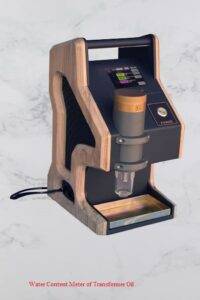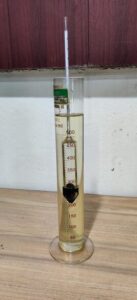
What is the Water Content Test of transformer Oil?
The water content of transformer oil refers to the amount of water in the oil. The presence of water in transformer oil can harm the performance and lifespan of the transformer. Water can accelerate the aging process of the oil and insulation materials, reduce the dielectric strength, and increase the risk of electrical faults in the winding.
Transformer oils are designed to have a shallow water content to maintain their insulating properties. Typically, industry standards or guidelines define the acceptable water content in transformer oil. The International Electrotechnical Commission (IEC) standard IEC 60422 and ASTM D6304-20 recommends a maximum water content of 35 parts per million (ppm) for new transformer oil and 50 ppm for oil in service, as well as limits, which vary according to voltage class (see table no. 3 in IEC 60422). For the < 72.5 KV class, 20 mg/kg is the specified value.


Various methods can be used to determine the water content in transformer oil, including Karl Fischer titration, a commonly used technique for accurate measurement. This method involves titrating the oil sample with a Karl Fischer reagent that reacts with water, allowing for the determination of the water content.
Understanding Transformer Oil
Transformer oil is a highly refined mineral oil with excellent electrical insulating properties. It possesses high dielectric strength, which allows it to withstand the electrical stresses encountered in transformers. Transformer oil also functions as a coolant, efficiently removing heat from the transformer’s core and windings.
Significance of Water Content in Transformer Oil
The presence of water content in transformer oil can harm transformers’ performance and reliability. Water is considered a contaminant in transformer oil because it can reduce the oil’s dielectric strength and accelerate its aging process. Therefore, it is crucial to monitor and control the water content in transformer oil within acceptable limits as per specification.
Excessive water content in transformer oil can reduce insulation properties, leading to an increased risk of electrical insulation breakdown. It can also damage solid insulation materials like pressboard sheets, CP sheets, and wood Leeds, further compromising the transformer’s performance. Additionally, water can accelerate the oxidation process in the oil, resulting in the formation of sludge and acidity by-products that can damage the transformer.
Water Content Test Methods
Various methods are used to measure the water content in transformer oil to ensure the optimal performance of transformers. These methods include the Karl Fischer titration method, the equilibrium moisture content method, and the online monitoring technique. Among these, the Karl Fischer titration method is widely used for its accuracy and reliability.
The Karl Fischer titration method is a chemical analysis technique that accurately determines the water content in transformer oil. It involves a titration process using a specialized reagent that reacts with the water molecules present in the oil. The amount of reagent consumed during the titration is directly proportional to the sample’s water content.
The equilibrium moisture content method measures the water content by analyzing the water vapor pressure in the oil. This method requires the oil sample to be equilibrated at a specific temperature and pressure, allowing the water vapor to reach equilibrium. The water content is then determined by measuring the pressure of the water vapor.
Online monitoring systems offer real-time monitoring of the water content in transformer oil. These systems utilize sensors that continuously measure the moisture level and provide instant feedback on the water content. Online monitoring is particularly beneficial in critical applications where immediate water ingress detection is essential.
Factors Affecting Water Content in Transformer Oil
Water can enter transformer oil through various sources and characteristics. External factors include environmental conditions such as humidity and rainfall, which can lead to moisture ingress. Internal factors include faulty seals, degraded insulation, or water-contaminated equipment or materials.
Moisture can also enter transformer oil during routine maintenance activities if precautions are not taken. For example, inadequate drying of transformer components before refilling with oil can introduce moisture into the system. Therefore, ensuring proper handling and storage practices is essential to minimize water contamination.
Effects of Water on Transformer Oil
Water in transformer oil can severely affect its performance and the overall transformer system. Water reduces the oil’s dielectric strength, which is critical for insulating the high voltages in transformers. Reduced dielectric strength increases the risk of electrical breakdown, leading to equipment failure and potential hazards.
Water contamination can also accelerate the aging process of the oil and the solid insulation materials within the transformer. It promotes the degradation of cellulose-based insulation, which can compromise the insulation’s ability to withstand electrical stresses. This deterioration can lead to reduced transformer life expectancy and increased maintenance costs.
Furthermore, water in transformer oil can initiate chemical reactions that produce acidic compounds. These acids can erode internal components, increasing wear and decreasing reliability. Additionally, water can contribute to forming sludge and sediment, which can clog filters, restrict oil flow, and hinder heat dissipation.

Prevention and Maintenance Strategies
Preventing water contamination in transformer oil is crucial for maintaining optimal transformer performance. Several strategies can help minimize the risk of water ingress and preserve the integrity of the oil:
- Proper sealing and insulation of transformer components to prevent moisture ingress.
- Regular inspection and maintenance of gaskets, seals, and breather devices.
- Implementing effective drainage systems to redirect water away from transformer installations.
- Ensuring proper storage and handling of transformer oil to avoid moisture absorption.
- Performing thorough drying of transformer components before oil refilling during maintenance or repair activities.
Regular maintenance practices, such as oil sampling and analysis, should be carried out to monitor the water content and overall condition of transformer oil. This proactive approach allows for the timely detection of water ingress and enables appropriate corrective actions to be taken.
Water Content Limits and Standards
The acceptable water content in transformer oil varies depending on industry standards and specific transformer applications. Typically, the recommended water content limit is below 20 to 35 parts per million (ppm), or 0.0020% to 0.0035%. However, specific applications may require lower water content levels to ensure optimal performance and longevity.

Adhering to these water content limits is essential for transformer reliability and safety. Regular testing and monitoring should ensure compliance with the standards and guidelines set by regulatory bodies and industry organizations.
Importance of Regular Testing
Regular testing and monitoring of the water content in transformer oil are crucial to maintaining the health and performance of transformers. It allows for early detection of any water ingress or contamination, enabling prompt corrective actions. Regular testing provides valuable information about the condition of the transformer oil, helping to identify any potential issues and prevent costly breakdowns or failures.
The frequency of water content testing may vary depending on factors such as transformer size, operating conditions, and industry regulations. However, it is generally recommended to conduct routine testing at regular intervals, such as annually or semi-annually. In addition to scheduled testing, any unusual operational events or suspected water contamination should trigger immediate testing to ensure the integrity of the transformer oil.
The testing process involves collecting oil samples from the transformer and subjecting them to analysis using appropriate techniques, such as Karl Fischer titration. The test results provide an accurate measurement of the water content in the oil, allowing for comparison with the acceptable limits and the identification of any necessary actions.
By implementing a proactive testing and monitoring programme, potential issues related to water content can be identified early on. This enables timely corrective measures, such as oil filtration, drying, or replacement, to maintain transformers’ optimal performance and longevity.
Conclusion
The water content of transformer oil is a critical parameter that significantly impacts the performance and reliability of transformers. Monitoring and controlling the water content within acceptable limits is essential to ensuring these vital electrical devices’ proper functioning and longevity.
Excessive water in transformer oil can lead to reduced dielectric strength, an increased risk of electrical breakdown, accelerated aging, and the formation of harmful by-products. Therefore, regular testing and water content monitoring are essential preventive measures to detect and promptly address any water contamination issues.
By following proper maintenance practices, implementing effective prevention strategies, and adhering to industry standards, transformer operators can minimize the risk of water contamination and ensure the transformer’s optimal performance and lifespan.
FAQs (Frequently Asked Questions)
Why is water content important in transformer oil?
The water content in transformer oil affects its insulating properties and can lead to electrical insulation breakdown and accelerated transformer aging.
What are the standard methods to test the water content of transformer oil?
Standard methods include Karl Fischer titration, equilibrium moisture content methods, and online monitoring systems.
What are the consequences of excessive water in transformer oil?
Excessive water can reduce dielectric strength, increase the risk of breakdown, accelerate aging, and contribute to forming sludge and acidic compounds.
How can water contamination in transformer oil be prevented?
Proper sealing, insulation, maintenance practices, and regular testing can help prevent water contamination in transformer oil.
What are the acceptable water content limits for transformer oil?
The acceptable water content limits vary, but typically, it is recommended to keep them below 20 to 35 ppm, or 0.0035%.
Remember, to ensure the uniqueness and originality of the content, it is advised to avoid copying and pasting directly from external sources. Instead, use the information from the provided URLs and write the article in your own words while maintaining the appropriate structure and flow.

Leave a Reply